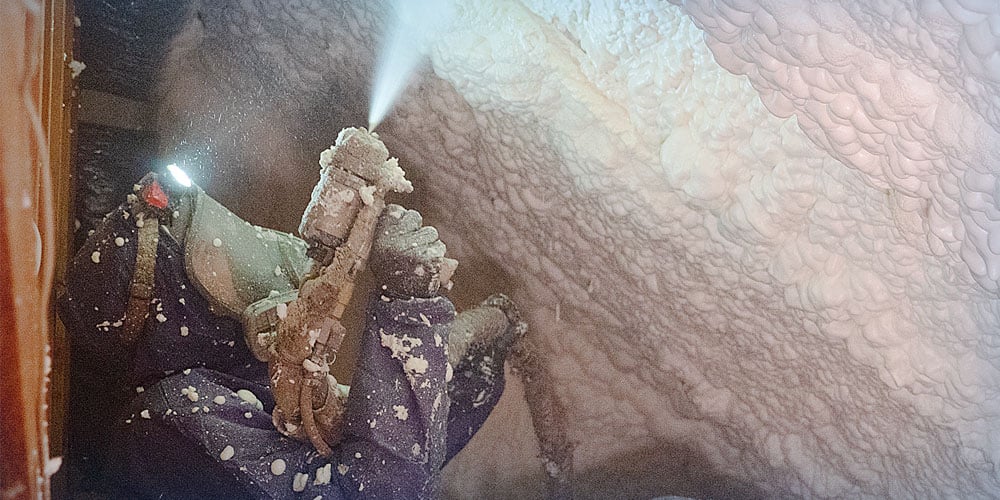The Magic Number: How Thick Should Spray Foam Insulation Be?
open cell spray foam insulation | spray foam insulation | closed cell spray foam insulation | foam university


When homeowners start thinking about spray foam insulation, one of the first questions that comes up is, “How much spray foam insulation do I need?”
It’s easy to assume that more foam means more comfort and better efficiency, but that’s not actually the case.
Just like adding more sunscreen after you’re already covered doesn’t protect you any better, piling on more spray foam doesn’t automatically make your home more efficient. Let’s break down the right spray foam insulation thickness for your home and why going overboard can just be a waste of money.
Key Points:
• More foam isn't better. Once the air seal is achieved, extra thickness doesn't add efficiency.
• Open cell foam: 6 to10 inches in attics and 3 inches in interior walls is enough to create an air seal.
• Closed cell foam: 4 to 5 inches on roof decks and 2 to 3 inches in wall cavities is enough to create an air seal.
• R-Value isn't everything. Air sealing is the real hero of energy efficiency.
• Rely on expert installers who understand both spray foam types and building science.
It's Not About "More," It's About the Air Seal
Traditional insulation materials like fiberglass or cellulose work by trapping air and slowing heat transfer.
To hit a specific R-Value, you need to layer them thicker and thicker.
Spray foam insulation works differently. Once it expands and creates an air seal, it stops conditioned air from escaping and unconditioned air from sneaking in. That’s where the comfort and energy efficiency come from, not from adding more inches of foam.
Once you hit that sweet spot, anything beyond that point doesn’t improve performance. It only adds unnecessary cost.
Open Cell Spray Foam: The Flexible Air Seal
Open cell spray foam is soft, spongy, and expands significantly, making it ideal for interior spaces.
It’s great at filling all those little cracks and crevices that cause drafts.
- Attics: You’ll need around 6 to 10 inches of open cell spray foam to create an air seal.
- Exterior Walls: About 3 inches does the trick.
That’s all it takes to create an effective air barrier. Adding more won’t increase comfort – it’ll just increase your install bill.
Closed Cell Spray Foam: Strong and Efficient
Closed cell spray foam is denser and more rigid.
It’s a strong, durable product that can withstand being knocked into in a pole barn or help with moisture control in a crawl space or attic.
- Roof Decks: Around 4 to 5 inches is ideal.
- Open Wall Cavities: 2 to 3 inches is usually enough to create an air seal.
Some homeowners think 10 to 12 inches will make things even better, but once the air seal is achieved, that extra foam doesn’t add value; it just adds cost.
Why R-Value Isn't the Whole Story
R-Value measures how well a material resists heat flow, but it doesn’t measure air leakage, and that’s where spray foam really shines.
Think of R-Value as the thickness of a blanket. It keeps you warm until a cold draft sneaks in. Spray foam eliminates that draft by sealing every gap and crack, so your home maintains even temperatures and your HVAC system doesn’t have to work overtime.
Trust the Pros (and the Specs) When it Comes to Spray Foam Insulation Thickness
The ideal spray foam insulation thickness depends on the type of foam, where it’s applied, and your climate zone.
Manufacturers test and publish specs for a reason, and experienced contractors know exactly how to achieve the perfect balance between R-Value and air sealing.
When in doubt, trust your spray foam installation professional – they’ll make sure you hit that magic number without wasting material or money. Remember, when it comes to how much spray foam you need, it’s not about loading up every inch of space with foam. It’s about getting the right amount to stop air movement.
If you’d like to learn more about creating an air seal in your home to make it more comfortable and energy efficient, check out the Learning Center on our website. There you’ll find tons of articles, videos, and resources to answer all of your questions.
Related Articles
What is Spray Foam Insulation?
Open Cell vs Closed Cell Spray Foam: What’s the Difference?
How to Prep for Spray Foam Insulation
FAQs About Spray Foam Insulation Thickness
How much spray foam insulation do I need for my attic?
For most attics, 6 to 10 inches of open cell spray foam or 4 to 5 inches of closed cell spray foam will create a proper air seal.
Does adding more spray foam make my home more efficient?
Nope.
Once the air seal is in place, adding more foam won't make your home any more efficient -- it just costs more.
What's the difference between open and closed cell spray foam?
Open cell foam is lighter, expands more, and is ideal for homes.
Closed cell spray foam is denser, more moisture-resistant, and great for pole barns and commercial buildings.
Is R-Value important with spray foam insulation?
Yes, but it's only part of the story.
R-Value measures heat resistance, but spray foam's air sealing ability is what really boosts comfort and energy savings.
About Amanda Emery
Amanda previously has worked as a breaking news and crime reporter, TV news producer, and editor. As a journalist, she has won several awards from The Society of Professional Journalists - Detroit Chapter and the Michigan Press Association. Amanda uses her experience as a journalist to write content that will help educate homeowners on foam insulation benefits. When Amanda isn’t writing, she’s spending time with her husband Chris, daughter Lilith-Maeve, and rescued huskies Danger and Wendigo. She also loves knitting, making art, and cooking.



